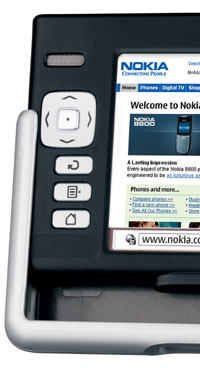New Nokia thingy - Nokia 770 - why?
Engadget has a good story on this new linux gadget . The question really is, why the hell did Nokia release this thing? (For a contrarian point of view, which I haven’t read yet, see this PC Mag article .)
I’m inclined to think that Nokia is generally speaking on the right track these days. The Nokia N-Series , despite the horrific flash on that page, looks really, really solid. They seem to have settled on a design aesthetic that’s actually pleasing again - witness the Nokia 8800 . Their open development platform strategy with Series 60 is a definitely winner.
So, the new device. It’s a small tablet-style device with a substantial screen (800x480) suitable for watching TV and movies on, and surfing the web. It’s got Wi-Fi and bluetooth. NB: no phone! It’s got 128 MB RAM but only 64 MB flash card. It runs linux! And not only that but the whole OS, dev kit included is GPL top to bottom, and Nokia seems keen to make this into a real open source community process.
So, that’s a pretty different set of specs from any other Nokia offering. It actually looks a bit more like something Apple would make.
So why is Nokia doing this? Speculation follows.
First there’s the ambition angle. They want to be more than a mobile phone maker. They’re breaking out into new markets. So, they leverage their ability to make clever small hardware. It’s a bit odd they would choose this particular niche to move into though, because it’s not a game device (PSP) and it doesn’t have a hard drive (iPod) so it doesn’t really seem to compete with any existing products.
They might be doing it to push forward open platforms . I think that Nokia is pretty seriously committed at this point to be pro-open and anti- walled garden . Which is good for us, whether by “us” you think I mean consumers or developers.
But the reason i think they’re really doing it is a power play against the operators . One of the major underlying stories of the mobile phone arena is the power struggle between operators and manufacturers. Both want to have all the customer loyalty and make all the decisions about what goes on and in the phones. Each one has their own revenue needs which conflict, because manufacturers don’t care about ARPU and carriers do.
Now, consider the Nokia N91 . I recently wrote a blog entry about Wi-Fi wireless VoIP cell phones and as it turns out (thanks Chris ;-) the Nokia N91 does everything that I asked for there. Who knew? There is of course one small problem, which is that the operators are none-too-pleased about the prospect of people stealing their ARPU by using wVoIP on home, office, and municipal Wi-Fi.
So how does that affect Nokia again? Oh yeah - they have to avoid getting slapped in the face like Apple and Motorola over the iTunes phone. If the operators feel too threatened by the N91 with both Wi-Fi, cellular, and also incidentally Skype … which they should! Well, then, they might refuse to carry the N91. And that would be a Bad Thing.
To finally get to the point, by releasing a completely non-cellular Wi-Fi convergence 770, Nokia can make the carriers look stupid if they don’t pick up the N91. Because they’ll still be selling a Wi-Fi device that has Skype or whatever on it, just not through the carriers.
